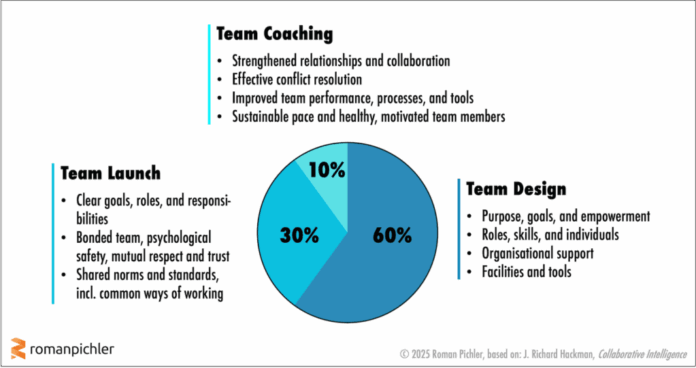Product groups are key in enabling product-led development and providing profitable merchandise. On this article, I clarify what product groups actually need to do an excellent job and how one can greatest assist the groups you’re employed with. I additionally provide a complete questionnaire within the article so you may design profitable product groups and get them off to an excellent begin, or if they’re up and working, present the conditions that could be lacking.
Hearken to the audio model of this text:
Product Groups: Advantages and Challenges
A product group is a gaggle of people that collaborate successfully, have possession of a product, and are answerable for reaching product success. Product groups have turn out to be common for a superb motive: “None of us is as good as all of us,” as Ken Blanchard as soon as stated. In different phrases, it is rather tough for a product particular person to make all choices by themselves, even when they’re very skilled.[1]
What’s extra, product folks depend on others to assist them progress their merchandise. This consists of UX designers, builders, and testers, in addition to entrepreneurs, gross sales reps, and buyer assist group members: They design, construct, market, promote, and assist the merchandise. Bringing the precise folks collectively permits you to leverage their collective experience, make the very best choices, and create alignment.[2]
Sadly, it’s not unusual for product groups to wrestle. I’ve met groups who lacked the precise group members and expertise, weren’t empowered to successfully progress their merchandise, and suffered from frequent adjustments to the group composition, to call only a few points. Consequently, their merchandise had a weak worth proposition, supplied a poor consumer expertise, and didn’t generate the specified enterprise advantages. In sum, the groups and their merchandise underperformed.
A typical management response is to supply teaching—attempting to assist the group carry out higher—and, in some circumstances, begin managing the group. Regardless of being well-intended, this may damage morale and additional hamper productiveness. Moreover, it could depart the chief exhausted and overworked. But it surely doesn’t should be this fashion.
The 60-30-10 Rule
Analysis by the late Harvard professor J. Richard Hackman means that the largest affect on a group’s efficiency derives from its design, not from real-time teaching interventions.[3] This perception is captured by the 60-30-10 rule proven in Determine 1.
Determine 1 distinguishes 3 ways during which the efficiency of product groups may be affected: group design, group launch, and group teaching. The largest affect on group efficiency, about 60%, is the group’s design, in line with Hackman. This consists of making certain that the precise folks be a part of the product group, that the group’s targets and authority are clear, and that the group receives the precise assist from the organisation, as I clarify in additional element within the subsequent part.
The second greatest affect comes from the group launch, roughly 30%. This consists of serving to the group members bond and establishing shared methods of working. Workforce teaching, lastly, has a relatively small affect on group efficiency, about 10% in line with Hackman. This doesn’t imply that it’s unimportant. The other is true. Product groups can vastly profit from having a certified coach.[4]
However growing a group is like rising a plant: If it’s been put within the flawed place, if the necessities for development usually are not met, then you may water and fertilise it as a lot as you need. It might by no means absolutely develop. Within the worst case, it can wither and die.
Workforce Design
The group design contains the required prep work for having an excellent group.[5] This consists of answering the next set of questions.
- What are the group’s goal and targets? What are its tasks? What stage of empowerment is required?
- Which roles and expertise, each task-oriented and social, are required to satisfy the targets and fulfil the tasks? Who ought to be a part of the group?[6]
- Which assist does the group want from the organisation? Who’s the (govt) sponsor? Who’s the group coach?
- Which instruments and atmosphere does the group require? Does the group want a group room or different amenities?
The questions above are a subset of a complete questionnaire I’ve developed that can assist you get the group design proper. You possibly can obtain it by clicking on Determine 2.
Whereas you need to, in fact, decide which group design is best for you, I typically suggest forming product groups that include the particular person in command of a product, a UX designer, architect/programmer, and tester, in addition to key enterprise stakeholders, like a marketer and gross sales rep, and a group coach. I additionally advocate empowering product groups to make strategic product choices, as I clarify in additional element within the article Constructing Excessive-Performing Product Groups.
Getting the group design proper may be tough, as you would possibly lack the authority to ascertain all enabling situations—to find out the group’s goal, select the members, guarantee the required organisational assist, and so forth. You could subsequently should affect senior administration and friends so you may present the group with what it must carry out effectively. To realize this, you’ll profit from strengthening your emergent/lateral management expertise, as I clarify within the article Decoding Product Management.
Workforce Launch
As vital as it’s, designing the group isn’t sufficient. To assist product groups succeed, you additionally should get the group launch proper. You’d be forgiven to suppose that the launch basically consists of the kick-off assembly. However that’s not right. “By the tip of a profitable launch, a group can have advanced from being only a listing of names into an actual (…) group. [Its] members can have begun growing and testing the norms of conduct that can information group conduct,” writes Hackman in his e book Collaborative Intelligence, p. 159.
To know what the group launch would possibly contain, we are able to correlate it with the group improvement phases advised by the Tuckman mannequin in Determine 3.
The mannequin in Determine 3 reveals that groups often should undergo a Forming and Storming stage earlier than they will turn out to be an actual group: Within the Norming stage, the group has began to jell. Its members empathise with and belief one another, they observe shared methods of working, they usually begin to collaborate successfully. The fourth stage in Determine 3 is named Performing. As its identify signifies, the group is now productive and does an excellent job at working in direction of its targets.[7]
The group launch—based mostly on my understanding of Hackman’s work—contains the Forming and Storming and the start of the Norming stage of the Tuckman mannequin, marked by the gray space in Determine 3. In contrast to a product launch, it’s subsequently not an occasion however a course of, which could final from a number of weeks to some months.
To know if the launch of a product group was profitable, ask your self the next questions.
- Do the members assist the group’s goal and targets? Do they perceive the group’s tasks and authority? Are the members clear on their roles?
- Do they really feel psychologically secure? Do they respect and belief one another? Has the group jelled?
- Have the people began to collaborate efficiently? Do they meet usually, and are the conferences efficient?
- Have the group members established shared processes and instruments? Do they use them?
Workforce Teaching
The final exercise group in Hackman’s 60-30-10 rule is ongoing teaching.[8] This consists of the next 5 actions:
However as talked about earlier than, if the group was not effectively designed or the launch was not profitable, teaching is unlikely to be efficient. The next story illustrates this. I as soon as labored with a group that continued to underperform regardless of my greatest teaching efforts. After admitting to myself that extra teaching was not the answer, I realised that the group setup was ill-conceived. This was not a straightforward step, as I used to be the supervisor in cost and had designed the group myself. I referred to as a gathering with the members, and we agreed to interrupt up the group and kind two new teams. Fortuitously, the story has a cheerful ending: The brand new groups carried out significantly better than the unique one.
Having stated this, I want to reiterate that product groups profit from having a certified coach obtainable who carries out the actions listed above. You must subsequently do every part you may to plan for a coach position throughout group design and have the person on board when the group is launched.
Notes
[1] Marty Cagan’s e book Impressed and Steve Haines’ The Product Supervisor’s Desk Reference have helped popularise product groups.
[2] A product group, subsequently, is a cross-functional group.
[3] See J. Richard Hackman, Collaborative Intelligence and Ruth Wageman, “The Workforce Diagnostic Survey and the 60-30-10 Rule for Teaching Groups.” Because of Arne Roock for making me conscious of the rule.
[4] Observe that the odds point out the significance of the three teams of actions. On this sense, Hackman’s 60-30-10 rule is a suggestion moderately than a hard-and-fast rule. Additionally, extra latest analysis into groups at Google discovered that how the groups labored collectively was extra vital than who was on the group. This doesn’t invalidate the significance of group design in my thoughts. But it surely challenges the odds advised by Hackman, assuming that Google’s findings are typically relevant.
[5] Hackman suggests in his e book Collaborative Intelligence that efficient groups should fulfil six situations: Actual Workforce (social system, clear boundaries, collective accountability, and a minimum of average stability), Compelling Objective, Proper Individuals, Clear Norms of Conduct, Supportive Context, and Workforce-focused Teaching. I tackle the situations on this part other than the norms of conduct, which I talk about within the part Workforce Launch.
[6] The GRPI mannequin, developed within the early Nineteen Seventies by Richard Beckard, additionally views clear targets and roles as essential for efficient teamwork.
[7] Observe that Tuckman later added a fifth stage referred to as Adjourning. I’m not exhibiting the stage in Determine 3, as it isn’t notably related to the dialogue.
[8] Hackman and Wageman outline group teaching as “direct interplay with a group supposed to assist its members make coordinated and task-appropriate use of their collective sources in carrying out the group’s work” in “A Idea of Workforce Teaching,” Academy of Administration Evaluation, 2005, Vol. 30, No. 2, p. 269.




